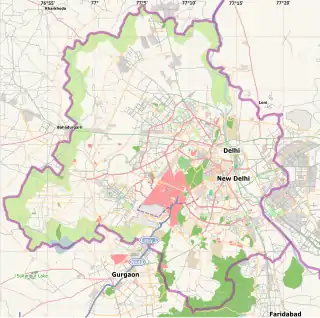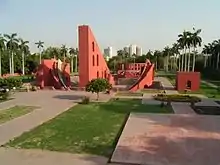Jantar Mantar, New Delhi
Jantar Mantar is located in the modern city of New Delhi. “Jantar Mantar” literally means “instruments for measuring the harmony of the heavens”. [1] It consists of 13 architectural astronomy instruments. The site is one of five built by Maharaja Jai Singh II of Jaipur, from 1723 onwards, revising the calendar and astronomical tables. Jai Singh, born in 1688 into a royal Rajput family that ruled the regional kingdom, was born into an era of education that maintained a keen intrest in astronomy. There is a plaque fixed on one of the structures in the Jantar Mantar observatory in New Delhi that was placed there in 1910 mistakenly dating the construction of the complex to the year 1710. Later research, though, suggests 1724 as the actual year of construction. Its height is 723 feet (220 m).
| Jantar Mantar, New Delhi | |
|---|---|
| Jantaram Mantaram | |
.jpg.webp) Misra Yantra at Jantar Mantar | |
| Type | Observatory |
| Location | New Delhi, India |
| Nearest city | New Delhi |
| Coordinates | 28°37′38″N 77°12′59″E |
| Height | 723 feet (220 m) |
| Founder | Maharaja Jai Singh II |
| Built | 1724 |
| Website | Official website |
 Location of Jantar Mantar, New Delhi in Delhi  Jantar Mantar, New Delhi (India) | |
The primary purpose of the observatory was to compile astronomical tables, and to predict the times and movements of the sun, moon and planets. Some of these purposes nowadays would be classified as astronomy.
Completed in 1724, the Delhi Jantar Mantar had decayed considerably by 1857 uprising. The Ram Yantra, the Samrat Yantra, the Jai Prakash Yantra and the Misra Yantra are the distinct instruments of Jantar Mantar. The most famous of these structure, the Jaipur, had also deteriorated by the end of the nineteenth century until in 1901 Maharaja Ram Singh set out to restore the instrument.[2] The most important issue concerning the Jantar Mantar is the loss of the fine, calibrated markings on the instruments, which are eroding. These precision machines needed to be completely restored in order to protect the historic function of these extraordinary instruments. In 2008, advocacy groups formed in an effort to encourage the Rajasthan government to restore the Jantar Mantar. The restoration proceeded and is now what we see today. In 2010, the Jantar Mantar was inscribed on the UNESCO World Heritage List.[2] The constant modification and corrections in the observed and mathematical tables of astronomy made these positional astronomical instruments play a key role in the continued study and development of astronomy across the globe.[3]
Purpose of individual structures
The 4 distinct instruments within the observatory of Jantar Mantar in New Delhi: the Samrat Yantra, the Jayaprakash, Rama Yantra and the Misra Yantra.
- Samrat Yantra: The Samrat Yantra, or Supreme Instrument, is a giant triangle that is basically an equal hour sundial. It is 70 feet high, 114 feet long at the base, and 10 feet thick. It has a 128-foot-long (39 m) hypotenuse that is parallel to the Earth's axis and points toward the North Pole. On either side of the triangle is a quadrant with graduations indicating hours, minutes, and seconds. At the time of the Samrat Yantra's construction, sundials already existed, but the Samrat Yantra turned the basic sundial into a precision tool for measuring declination and other related coordinates of various heavenly bodies. The Vrihat Samrat yantra can calculate the local time at an accuracy of up to two seconds and is considered the worlds largest sundial.[1]
- Jaya Prakash Yantra: The Jaya Prakash consists of hollowed out hemispheres with markings on their concave surfaces. Crosswires were stretched between points on their rim. From inside the Ram, an observer could align the position of a star with various markings or a window's edge. This is on of the most versatile and complex instruments that can give the coordinates of celestial objects in multiple systems- the Azimuthal-altitude stytem and the Equatorial coordinate system. This allowed for the easy conversation of the popular celestial system.[3]
- Rama Yantra: Two large cylindrical structures with open top, used to measure the altitude of stars based on the latitude and the longitude on the earth.
- Misra Yantra: The Misra Yantra (literally mixed instrument) is a composition of 5 instruments designed as a tool to determine the shortest and longest days of the year. It could also be used to indicate the exact moment of noon in various cities and locations regardless of their distance from Delhi. The Misra yantra was able to indicate when it was noon in various cities all over the world and was the only structure in the observatory not invented by Jai Singh II.
- Shasthansa Yantra: Using a pinhole camera mechanism, it has been built within the towers that support the quadrant scales. It is used to measure specific measurements of the sun such as the zenith distance, declination, and diameter of the sun.[3]
- Kapala Yantra: Built on the same principle as the jai Prakash, the instrument is used more as a demonstration to indicate the transformation of one coordinate system to another. Not used for active celestial observation.[3]
- Rasivalya Yantra: Twelve of these structure where built, each referring to the zodiacal constellations by measuring the latitude and longitude of a celestial object at the very moment the celestial object crosses the meridian. [3]
Other observatories
Between 1727 and 1734 Jai Singh II built five similar observatories in west-central India, all known by the name Jantar Mantar. They are located at
While the purpose of the Jantar Mantar was astronomy and astrology (Jyotish), they are also a major tourist attraction and a significant monument of the history of astronomy.
Gallery
 Jantar Mantar, New Delhi
Jantar Mantar, New Delhi The Jantar Mantar in 1858, damaged by fighting during the Indian Rebellion of 1857
The Jantar Mantar in 1858, damaged by fighting during the Indian Rebellion of 1857.jpg.webp) West tower of Samrat Yantra
West tower of Samrat Yantra.jpg.webp) Centre tower Samrat Yantra
Centre tower Samrat Yantra.jpg.webp) East tower Samrat Yantra
East tower Samrat Yantra.jpg.webp) Rama Yantra (North of the two Rama Yantra)
Rama Yantra (North of the two Rama Yantra).jpg.webp) Inside view of Rama Yantra 2 of Jantar Mantar
Inside view of Rama Yantra 2 of Jantar Mantar Inside view of Rama Yantra of Jantar Mantar Closeup
Inside view of Rama Yantra of Jantar Mantar Closeup Inside view of Rama Yantra of Jantar Mantar Details
Inside view of Rama Yantra of Jantar Mantar Details Shastansh Yantra - East Side
Shastansh Yantra - East Side Shastansh Yantra - West Side
Shastansh Yantra - West Side
References
- GURJAR, ROHIT (10 February 2017). "JAIPUR JANTAR MANTAR :WORLDS LARGEST SUNDIAL". Medium. Retrieved 15 December 2020.
- "Jantar Mantar". World Monuments Fund. Retrieved 15 December 2020.
- "Jaipur's Jantar Mantar: Legacy of an Astronomer-King". www.livehistoryindia.com. Retrieved 15 December 2020.
- Introduction www.jantarmantar.org.
- Awake (2005). Jantar Mantar An Observatory Without Telescopes. Awake,86 (13),18-20.
- Jantar Mantar British Library
Further reading
- Comprehensive report on history and instrument design at Jantar Mantar
- Sharma, Virendra Nath (1995). Sawai Jai Singh and his astronomy. Motilal Banarsidass Publishers Pvt. Ltd. ISBN 81-208-1256-5.
- Articles on Jantar Mantar
External links
- Jantar Mantar - The Astronomical Observatories of Jai Singh II
- Observations on Jantar Mantar in New Delhi
- Step Inside Jantar Mantar in New Delhi
- Architectural Astronomy Instruments (video in English)
- Jantar Mantar—An Observatory Without Telescopes (in English)
- जंतर मंतर—बगैर टेलिस्कोप की वेधशाला (in Hindi)
| Wikimedia Commons has media related to Jantar Mantar (Delhi). |